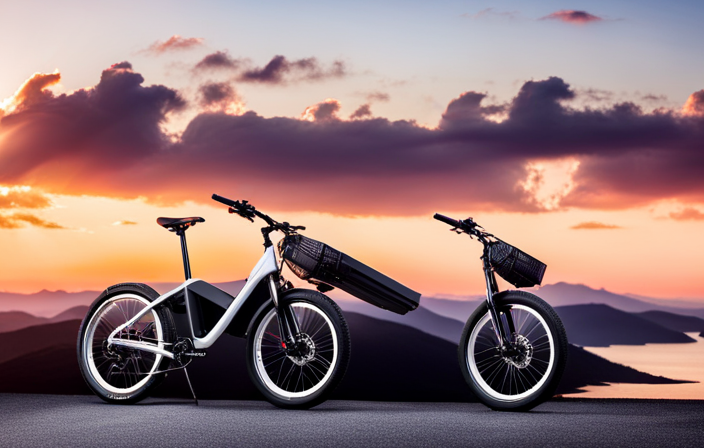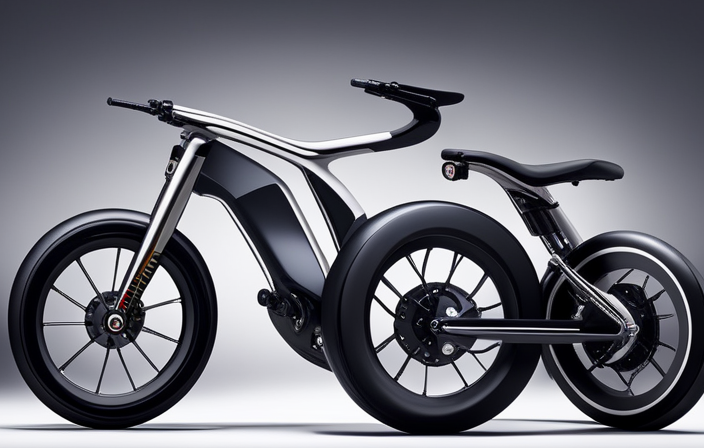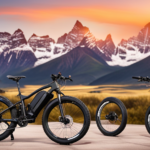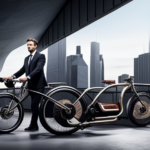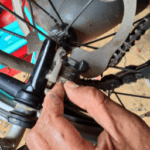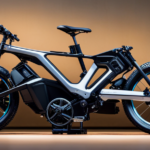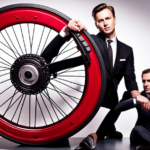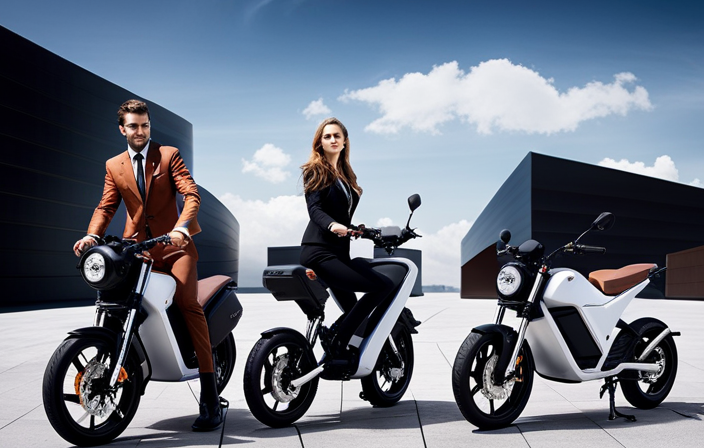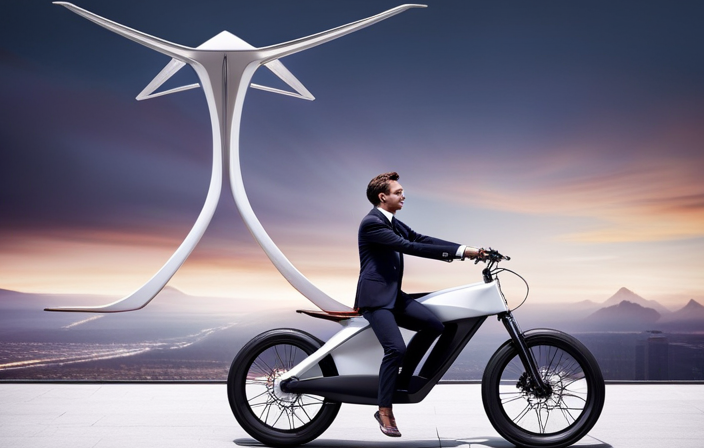Hey there! Ready to take your mountain biking experience to the next level?
In this article, I’m going to show you how to make your very own electric mountain bike. With a bit of know-how and the right tools, you’ll be cruising up those steep inclines in no time.
So, buckle up and get ready to electrify your ride. Let’s dive in!
Key Takeaways
- Ensure the bike’s system is functioning well and adjust the gearing system for optimal performance.
- Install electric bike accessories such as lights, bells, reflectors, and throttle or pedal assist sensor.
- Start with short rides to get familiar with electric assistance and gradually increase distance and difficulty.
- Choose the right battery based on capacity, voltage, range, and riding style to maximize potential.
Assess Your Bike and Determine Compatibility
Before you start making your mountain bike electric, it’s important to assess your bike and determine if it’s compatible for the conversion.
Evaluating battery options and choosing an appropriate motor are essential steps in this process.
When evaluating battery options, consider factors such as capacity, voltage, and weight. Opt for a high-capacity battery that can provide sufficient power for your desired riding distance. Additionally, choose a battery with the appropriate voltage to match the motor you plan to install.
As for the motor, consider factors like power output, efficiency, and compatibility with your bike frame. Look for a motor that provides enough power to meet your riding needs while being compatible with your bike’s frame design.
Once you have assessed your bike and determined compatibility, you can move on to selecting the right electric conversion kit.
Choose the Right Electric Conversion Kit
To choose the right electric conversion kit, you’ll want to consider factors such as your budget and the desired level of power for your bike. Electric conversion kit prices can vary depending on the brand and features included. It’s important to research and compare different types of electric conversion kits to find the one that suits your needs.
There are several options available, including front wheel, rear wheel, and mid-drive conversion kits. Each type has its own advantages and considerations, such as ease of installation and performance. Front wheel kits are typically the most affordable, while mid-drive kits offer better torque and climbing ability.
Once you’ve determined the type of kit that fits your requirements, you can move on to gathering the necessary tools and equipment for the installation process.
Gather the Necessary Tools and Equipment
You’ll need certain tools and equipment to complete the installation of the electric conversion kit. Assessing compatibility and choosing the right conversion kit is crucial, but having the proper tools is equally important. Here are the essential items you’ll need:
- Wrench set: A set of wrenches in various sizes will be necessary for removing and tightening bolts and nuts.
- Screwdriver set: Phillips and flathead screwdrivers will be needed for removing and installing screws.
- Wire cutters/strippers: These tools are essential for cutting and stripping wires during the electrical connections.
- Allen wrench set: Mountain bikes often use hex bolts, so having a comprehensive set of Allen wrenches will come in handy.
- Pliers: Pliers are useful for gripping and twisting wires or tightening small components.
With these tools at your disposal, you’ll be well-prepared to embark on the next section. In the next section, we will remove non-essential components to make room for the electric conversion kit.
Remove the Non-Essential Components
First, start by removing any unnecessary components from your bicycle to create space for the conversion kit. This step is crucial for ensuring a smooth installation process and optimizing the performance benefits of your electric mountain bike. By eliminating non-essential parts such as fenders, kickstands, and front derailleur systems, you’ll have ample room to accommodate the electric components without compromising the bike’s stability or functionality.
Additionally, removing these components will help reduce the overall weight of the bike, improving its maneuverability and climbing capabilities. However, it’s important to consider safety considerations during this process. Make sure to disconnect the battery, wear appropriate protective gear, and follow proper instructions to avoid any accidents.
With the unnecessary components removed, you’re now ready to move on to the next section and install the electric conversion kit seamlessly.
Install the Electric Conversion Kit
Now that the non-essential components have been removed, it’s time to install the electric conversion kit. This process is crucial in transforming a regular mountain bike into an efficient and powerful electric one.
The electric conversion kit consists of various components, including a motor, battery, controller, and wiring harness. The benefits of electric mountain bikes are numerous, with increased speed, extended range, and enhanced climbing capabilities being just a few.
To begin the installation, attach the motor to the bike’s frame using the provided brackets and hardware. Then, mount the battery securely in a suitable location. Connect the controller to the motor and battery using the wiring harness, ensuring all connections are secure.
Connect the Wiring and Test the System
To successfully connect the motor, battery, and controller in an electric conversion kit, it’s crucial to follow a step-by-step process.
First, ensure that the motor is securely attached to the bike frame and that all necessary wiring connections are made.
Next, connect the battery to the controller, making sure to match the positive and negative terminals correctly.
Connect the Motor, Battery, and Controller
You can easily connect the motor, battery, and controller to make your mountain bike electric.
When choosing the right motor, battery, and controller, it is important to consider factors such as power output, voltage compatibility, and size.
The motor should have sufficient power to provide the desired level of assistance, while the battery should have enough capacity to support your riding needs.
The controller acts as the brain of the system, allowing you to control the motor’s speed and power output.
To ensure proper electrical connections, follow the manufacturer’s instructions and use the appropriate connectors and wiring.
It is crucial to double-check all connections before testing the system for proper functioning.
Once everything is connected, you can move on to the next step of testing the system to ensure it is working correctly.
Test the System for Proper Functioning
To ensure that the system is functioning properly, you should thoroughly test it before using it.
Testing the electric bike system is crucial to troubleshoot common issues and optimize its performance.
Start by checking all the connections between the motor, battery, and controller to ensure they are secure and properly aligned.
Once the connections are verified, power up the system and test the throttle response and speed control.
Take the bike for a test ride, paying attention to any unusual noises, vibrations, or loss of power.
Troubleshoot any issues by checking the electrical connections, adjusting the settings on the controller, or inspecting the motor and battery.
By thoroughly testing the system, you can identify and address any potential problems before hitting the road.
Once the system is functioning well, you can move on to adjusting the bike’s gearing system to further optimize its performance.
Adjust the Bike’s Gearing System
Start by loosening the bolts on the rear derailleur to adjust the bike’s gearing system. This is an essential step in making a mountain bike electric, as it allows you to optimize the bike’s performance and increase efficiency.
By adjusting the gearing system, you can ensure that the bike is in the perfect gear ratio for different terrains and riding conditions. This will not only improve the bike’s overall performance but also make it easier to pedal and navigate through challenging trails.
Once the gears are properly adjusted, you can move on to the next step of installing the electric bike accessories, such as the motor and battery, to transform your mountain bike into an electric powerhouse.
Install the Electric Bike Accessories
When it comes to installing electric bike accessories, there are two key points to consider: adding lights, bells, and reflectors, and considering installing a throttle or pedal assist sensor.
Adding lights, bells, and reflectors is crucial for safety, as it increases visibility and alerts others of your presence.
Additionally, considering installing a throttle or pedal assist sensor can enhance your riding experience by providing additional power and control.
Add Lights, Bells, and Reflectors
Make sure you’ve got lights, bells, and reflectors on your mountain bike to enhance safety and visibility. Here are three essential accessories to consider adding:
-
Lights: Install a front headlight and a rear taillight to ensure visibility in low-light conditions. Look for LED lights with a high lumen output for maximum brightness.
-
Bells: Adding a bell to your handlebars allows you to alert pedestrians and other cyclists of your presence. Choose a bell with a loud, clear sound that can be easily heard.
-
Reflectors: Attach reflective strips or stickers to your bike frame, pedals, and wheels to increase visibility from all angles. Reflectors are especially important when riding at night or in areas with heavy traffic.
By equipping your mountain bike with these accessories, you’ll significantly improve your safety on the road.
Now, let’s move on to the next section and consider installing a throttle or pedal assist sensor to make your bike electric.
Consider Installing a Throttle or Pedal Assist Sensor
Consider equipping your bike with a throttle or pedal assist sensor to enhance your riding experience. Installing a torque sensor or pedal assist sensor can greatly improve the performance and efficiency of your electric mountain bike. While both options provide assistance to the rider, there are distinct advantages to choosing pedal assist over throttle control.
With pedal assist, the sensor detects the force applied to the pedals and provides a proportionate amount of power to assist your pedaling. This allows for a more natural and intuitive riding experience, as the motor seamlessly integrates with your own effort. On the other hand, throttle control provides a constant level of power regardless of your pedaling input, which can feel less responsive and may drain the battery faster.
To further illustrate the differences, here is a comparison table:
| Pedal Assist | Throttle Control | |
|---|---|---|
| Responsiveness | Directly proportional to pedaling effort | Constant power regardless of pedaling |
| Battery Efficiency | Optimized power usage | May drain battery faster |
| Riding Experience | Natural and intuitive | Less responsive and disconnected |
Take Your Electric Mountain Bike for a Test Ride
When it comes to taking your electric mountain bike for a test ride, it’s important to start with short rides to get familiar with the electric assistance. This will allow you to understand how the bike handles and how the electric motor works.
As you become more comfortable, you can gradually increase the distance and difficulty of your rides to push yourself and fully experience the capabilities of your electric mountain bike.
Start with Short Rides to Get Familiar with the Electric Assistance
Take it slow and go for short rides to get comfortable with the electric assistance on your mountain bike. Starting with short rides is crucial to familiarize yourself with the benefits of an electric bike and the different settings available.
One of the key benefits of an electric bike is the ability to choose the right battery that suits your riding style and needs. It’s important to understand the battery’s capacity, voltage, and range to ensure you have enough power for your rides. By starting with short rides, you can gauge how much assistance you need and how long the battery lasts. This will help you make informed decisions when it comes to choosing the right battery for your electric mountain bike.
Gradually increasing the distance and difficulty of your rides will allow you to fully explore the capabilities of your electric bike and maximize its potential.
Gradually Increase the Distance and Difficulty of Your Rides
As you gradually increase the distance and difficulty of your rides, you’ll be able to push yourself and fully explore the capabilities of your e-bike. This not only increases your endurance but also improves your technical skills. By challenging yourself with longer rides and tougher terrains, you’ll become more comfortable and proficient in handling your electric mountain bike. Here’s a table to help you track your progress as you push your limits:
| Ride Distance (miles) | Difficulty Level | Endurance Level | Technical Skills |
|---|---|---|---|
| 5 | Easy | Low | Basic |
| 10 | Moderate | Medium | Intermediate |
| 20 | Hard | High | Advanced |
| 30 | Challenging | Max | Expert |
Maintain and Care for Your Electric Mountain Bike
It’s important to regularly clean and lubricate the chain of your electric mountain bike to ensure optimal performance.
Electric bike maintenance is crucial in order to keep your bike running smoothly and avoid common issues.
One common problem riders encounter is a noisy or squeaky chain. This can be caused by a lack of lubrication or dirt buildup. To troubleshoot this issue, start by thoroughly cleaning the chain with a degreaser and a brush. Once clean, apply a high-quality bicycle chain lubricant to ensure smooth operation.
Another common issue is poor shifting. This can often be resolved by adjusting the derailleur or replacing worn-out cables.
Regularly inspecting and maintaining your electric mountain bike will not only prolong its lifespan but also enhance your riding experience.
Frequently Asked Questions
Is it difficult to install an electric conversion kit on a mountain bike?
Installing an electric conversion kit on a mountain bike is relatively straightforward. It offers numerous benefits, including increased speed, extended range, and the ability to tackle challenging terrains with ease.
How long does it typically take to complete the installation of an electric conversion kit?
Typically, the installation of an electric conversion kit on a mountain bike takes around 2-3 hours. The process involves mounting the motor, attaching the battery, connecting the wiring, and ensuring proper alignment and functionality. While not overly difficult, it requires some technical know-how.
Can any type of mountain bike be converted into an electric bike?
Yes, any type of mountain bike can be converted into an electric bike. Different types of electric motors can be used, such as hub motors or mid-drive motors, each with their own pros and cons. Electric conversion kits provide an efficient and cost-effective way to transform your bike into an electric one.
Will adding an electric conversion kit affect the weight and performance of the mountain bike?
Adding an electric conversion kit to a mountain bike can significantly impact its weight and performance. On average, these kits can add an extra 15-20 pounds to the bike, affecting its handling and making it less agile on trails.
Are there any legal restrictions or regulations regarding the use of electric mountain bikes?
There are various regulations and legal restrictions on electric mountain bike use. These include speed limits, age restrictions, and requirements for lights and reflectors. It is important to familiarize yourself with the e mountain bike rules and regulations in your area.
Conclusion
In conclusion, converting a mountain bike into an electric bike is an exciting and rewarding project that can enhance your riding experience. By following the steps outlined in this article, you can successfully transform your bike into a powerful and efficient electric machine.
It is worth noting that the electric bike industry is experiencing rapid growth, with global sales of electric bikes expected to reach 40 million units by 2025. This statistic showcases the increasing popularity and demand for electric bikes, making it a great time to delve into the world of electric mountain biking.
So, get ready to embrace the thrill of riding an electric mountain bike and enjoy the benefits of this innovative technology.
